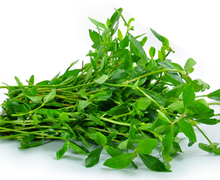
- Address : P.O. Box 11, Gannoruwa rd, Peradeniya, Sri Lanka
- E- Mail : director.hordi@doa.gov.lk
- Telephone :(+94) 081-2388011-12-13
- Fax :(+94) 081-2388234

Mukunuwenna
Alternanthera sessilis
Mukunuwenna is the commercially grown and most popular leafy vegetable type in the market. This is popular due to its nutritional, medicinal and characteristic flavor. The crop is rich in vitamins, calcium and iron
Available Types
- Vine type
- Bushy type
Vine type : this type is grown commercially
- Type with oval shaped leaves and light green colored stem. Most popular type in the market (Piliyandala type)
- Type with oval shaped leaves, brown and green colurs mixed stem.Internodes are very short, mostly grown in pannipitiya, Arawwala areas
- Type with long oval shped leaves and brown coloured stem.
- Type with large, long leaves, internodes are long with brown or green stem
- Type with lanceo late leaves and green or brown colured stem (Weda Mukunuwenna).
- Type with long , narrow leaves , internodes are long
Climatic requirements/ Areas suitable for cultivation
Low country wet zone is most suitable for the cultivation. If irrigation facilities are available it can be grown in any other areas in the country
Soil
Well drained low lands are more suitable for the cultivation. If the irrigation facilities are available, the crop can be grown in uplands. Suitable pH rage is 6-7.
Propagation
Stem cuttings are used for the propagation. 10-12 cm or longer cuttings can be planted or broadcasted.
Land preparation
Raised beds for low lands (paddy fields) and sunken beds for highlands are more suitable.
Soil is ploughed and allowed weeds to decompose. Then the fields are filled with water and take a fine filth and levelled. Drains are prepared to facilitate the drainage.
Planting
Stem cuttings are planted in specified spacing or randomly. Single cutting is planted at one point.
Spacing
Stem cuttings can be planted randomly or with the recommended spacing. Inter row spacing is 20 cm and intra row spacing is 10 cm
Fertilizer
Organic fertilizer and chemical fertilizers are applied poultry manure is the commonly used organic fertilize in commercial cultivations. Nematode problem can be minimized by using poultry manure.
Fertilizers for 1000m2 (1/4 AC) area
-organic fertilizers 01 ton
-chemical fertilizers
| Time of Apply | Urea kg | TSP kg | MOP kg |
Basal – Applied 1-2 days before planting | 9.0 | 13.5 | 10.0 |
Top dressing – After first harvesting | 9.0 | – | – |
Top dressing – 2 nd harvesting and followed it at each harvesting | 5.5 | – | 1.5 |
Top dressing – at every 6 months | – | 6.5 | – |
Water supply
Irrigation is done frequently to maintain the moisture at the top layer of the bed. Water lodging should be avoided.
Weed Control
During the land preparation weeds should be controlled as much as possible. Hand weeding should be practiced throughout the cropping cycle
Pest Management
Disease Management
Causal agent : This is caused by Cercospora sp.
Disease Transmission : This fungus is spread by soil and wind with infected plant parts.
Disease symptoms : Red or purplish brown spots appear on the leaves and spread throughout the leaf. Later the leaf turns to yellow color and dies.
Control of Leaf Spot Diseases
- If the disease is spreading intensively, harvest quickly and remove the diseased plant parts and burn them.
- Provide proper nutrition for cultivation.
- Avoid unnecessary application of nitrogenous fertilizers
- Following crop rotation
- Use healthy planting material for replanting.
In home gardening and organic farming
Liquid inoculation can be used to control Trichoderma asperellum leaf spot disease in home gardens and organic farming.
- Treatment of planting material and planting
- Trichoderma asperellum (Trichoderma asperellum) liquid infusion (100 ml in 10 liters of water) immersed for 10 minutes and planted.
- Spray the Trichoderma asperellum solution every week after planting to thoroughly wet the plants and soil (pre-harvest period 7 days).
This is caused by Albugo sp.
Disease Transmission : This disease spread by soil and wind with infected plant parts.
Disease symptoms
- White spots appear on the underside of the leaves. White powdery fungal spores are produced in spots on the underside of leaves. The base of the plant is larger than normal. The leaves of the apical bud shrivel to the underside and stop growing. Damaged leaves turn to the yellow color and then fall off.
Control of Leaf Spot Diseases
- If the disease is spreading intensively, harvest quickly and remove the diseased plant parts and burn them.
- Provide proper nutrition for cultivation.
- Avoid unnecessary application of nitrogenous fertilizers
- Following crop rotation
- Use healthy planting material for replanting.
In home gardens and organic farming
Liquid inoculation can be used to control Trichoderma asperellum leaf spot disease in home gardens and organic farming.
- Treatment of planting material and planting
- Trichoderma asperellum (Trichoderma asperellum) liquid infusion (100 ml in 10 liters of water) immersed for 10 minutes and planted.
- Spray the Trichoderma asperellum solution every week after planting to thoroughly wet the plants and soil (pre-harvest period 7 days).
Harvesting
First harvest can be obtained at four weeks after planting. Harvesting can be done at every 3-4 weeks after first harvesting.
Yield
1000-1200kg of harvest can be obtained at once from 1000 m2 field.
By maintaining the field properly the crop can be harvested for two years. (8-10 picks in one year)\
At about 2 years the yield is reduced and the crop should be removed. Crop rotation should be practiced without planting the same crop again in the field.
